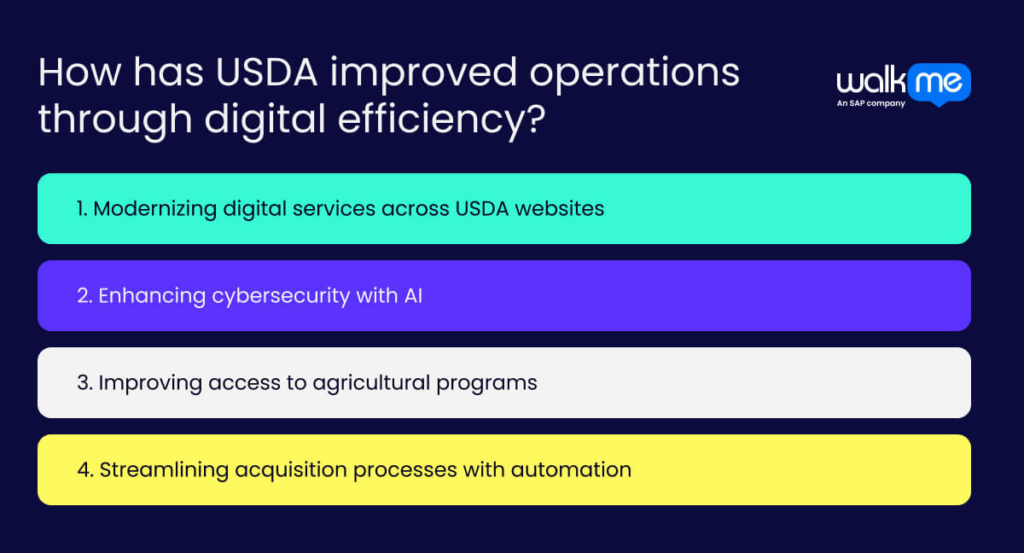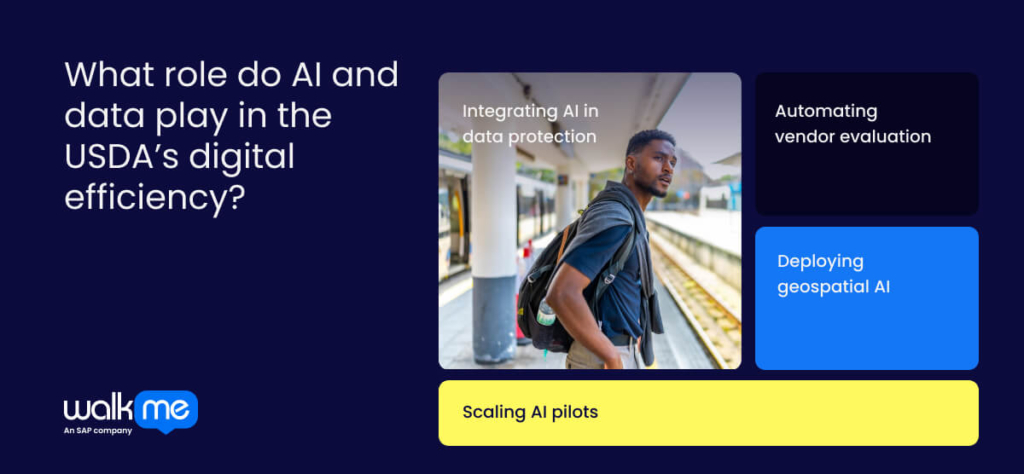Digital efficiency at the U.S. Department of Agriculture (USDA) powers national food security, rural development, and scientific insights.
The USDA’s Digital Infrastructure Services Center (DISC) strengthened its cloud migration, creating a secure, customer-focused service platform. This sped up the move to AgCloud systems and improved the USDA’s network upgrades.
Across farms, digital agriculture tools now cover more than two-thirds of row crop acreage, boosting input efficiency and yield by up to 13%. These advances fortify supply chains and allow rural America to thrive, underscoring why USDA must double down on digital transformation.
Underneath the surface, it signals a deeper shift in government, moving from static systems to adaptive infrastructure that responds to climate, markets, and community needs in near real-time.
This article explores how the USDA uses digital efficiency to transform farming, strengthen rural services, and future-proof U.S. agriculture.
What is the digital efficiency of the Department of Agriculture?
Digital efficiency in the Department of Agriculture means enhancing service delivery, streamlining operations, and supporting agricultural stakeholders.
It involves using technology adoption and data integration to reduce delays and enable smarter decision-making across the entire agricultural ecosystem.
A notable example is the USDA’s collaboration with the University of Arizona and Bridgestone Americas to develop a climate-smart natural rubber supply chain. This initiative integrates data-driven practices, including soil carbon modeling and greenhouse gas measurements, to promote sustainable agriculture.
Such efforts demonstrate how digital efficiency transforms traditional agriculture into a more resilient, transparent, and environmentally responsible system, one that is well-equipped to meet future challenges.
Why is digital efficiency important in the Department of Agriculture?
Enhancing digital efficiency at the USDA means providing faster and clearer assistance to farmers and rural communities. It reduces paperwork, streamlines program access, and ensures decisions are based on up-to-date information.
The USDA recently introduced the CropVista platform, which utilizes satellite imagery to monitor crop health and weather conditions across 17 states. This tool helps farmers make timely decisions, improving yields and reducing wastefulness.
Investing in such technologies strengthens the USDA’s ability to adapt and thrive, ensuring food security and supporting economic growth in rural America.
These advancements protect livelihoods and drive digital innovation that benefits the entire agricultural supply chain.
How has USDA improved operations through digital efficiency?

Now that you know what digital efficiency means at the USDA and why it matters, it’s time to examine how the department has enhanced operations through these efforts. Understanding this will help you see how technology drives practical improvements and supports agricultural resilience.
Modernizing digital services across USDA websites
The USDA recently adopted digital workflows that replace manual document handling. Electronic signatures and digital tracking accelerate contract approvals by 40%. This reduces bottlenecks, ensuring that farms and USDA programs receive the necessary supplies and services. It also helps improve responsiveness and reduce administrative costs.
Enhancing cybersecurity with AI
The USDA utilizes AI-powered security tools that analyze network traffic for unusual patterns in real-time. This early detection cuts response times by 30% and prevents breaches. Automated alerts notify teams immediately, securing sensitive agricultural data and safeguarding the USDA’s infrastructure from increasingly sophisticated cyber threats.
Improving access to agricultural programs
Guided online portals simplify application forms into easy steps with real-time error checks, cutting submission mistakes by 25% and speeding approvals. Clear status updates and reminders help farmers stay informed, boosting program participation and ensuring timely access to financial support.
Streamlining acquisition processes with automation
Automating USDA’s purchasing steps eliminated slow paperwork, cutting contract approval times by nearly 40%. Digital tracking tools accelerate the delivery of equipment and services to agricultural programs. This streamlining lowers delays and costs, enabling USDA to support farmers and rural initiatives with timely resources.
What role do AI and data play in the USDA’s digital efficiency?

AI and data have become two of the most talked-about terms recently, yet their impact runs far deeper. The USDA leverages these technologies in ways often unseen, such as improving crop monitoring and streamlining resource allocation.
Integrating AI in data protection
The USDA uses Darktrace, an AI cybersecurity platform, to monitor unusual behavior across its networks. It flags threats like unauthorized access or data misuse instantly, cutting response times and preventing breaches. This protects sensitive data tied to farm subsidies, SNAP, and rural development grants.
Automating vendor evaluation
An AI-powered Procurement Forecast tool now scans past vendor performance, pricing, and delivery records to rank suppliers by cost, reliability, and contract history. Replacing weeks of manual review with instant insights, it boosts accountability and significantly shortens procurement timelines.
Deploying geospatial AI
The USDA uses NASA Harvest’s geospatial AI tools to analyze satellite imagery for crop health, soil moisture, and yield estimates. Combined with LandPKS, this tech pinpoints drought risks and land degradation. Staff use this data to guide disaster relief and improve conservation targeting across thousands of acres.
Scaling AI pilots
The USDA’s Climate-Smart Commodities pilot applied machine learning (ML) models developed with Microsoft Azure to track emissions from farms. After early success, the system is being expanded to monitor fertilizer use and soil carbon across multiple states. This shift enables better data-driven climate reporting with less manual input.
What are the core pillars of USDA’s digital efficiency?
Now that we’ve explored how digital efficiency improves operations and the role of AI and data, it’s time to examine the core pillars. Understanding these pillars is crucial because they explain how digital efficiency is built, scaled, and sustained at the USDA.
Customer-first digital modernization
Making digital tools straightforward and useful for farmers and rural users is essential. A redesigned farmers.gov offers faster access to loans and disaster aid, with clear steps and mobile-friendly pages. This customer-centric approach reduces errors and phone calls, letting people get help without frustration. The focus is on solving real problems, not just upgrading websites.
Precision agriculture technologies
Farming uses data-driven tech like satellites and soil sensors to improve crop health and reduce waste. With help from USDA programs, more than two-thirds of row crops now benefit from these tools. This technology also lets farmers water and fertilize more precisely, leading to bigger harvests and lower costs while supporting sustainable land use.
Data-driven decision-making
Accurate data helps target support where it’s needed most. The USDA’s systems combine information from many sources to spot issues like duplicate subsidy payments or drought effects. This insight speeds up funding decisions, making programs work more resourcefully.
Executive prioritization of service delivery
Top USDA leaders track how quickly applications are processed and how well websites perform. Regular reviews ensure teams resolve problems and meet user needs. This focus on results means that technology investments improve services that farmers and rural communities use, rather than sitting idle.
Building internal digital skills
The USDA offers courses on cloud computing, automation technology, and cybersecurity to help employees train on modern tools. Skilled teams solve problems faster, rely less on outside help, and keep improving systems. This internal expertise helps the USDA adapt quickly, ensuring that technology investments translate into real-world results.
How does precision agriculture drive digital efficiency and operational gains at the USDA?
Understanding how precision agriculture drives efficiency is key to grasping the USDA’s impact on modern farming practices. This section reveals how a data-driven culture supports more resilient food systems nationwide.
Reducing costs and improving compatibility
Using precision tools like GPS-guided tractors and soil sensors, farmers cut fuel and fertilizer waste. The USDA helps farmers adopt systems that plug into their current equipment, avoiding the need for expensive upgrades. This saves money and keeps farms running smoothly without disruption.
Fixing data and standards issues
Data from sensors, drones, and weather stations often comes in different formats. The USDA works to create common data standards so farmers and apps can share and understand information easily. This makes digital tools more reliable and helps farmers act faster on accurate information.
Driving policy and technology solutions
The USDA analyzes crop and soil data to decide which programs to fund. For example, they support technology that boosts drought resistance based on real farm results. This focused investment ensures that taxpayer dollars help tools that improve farm yields and sustainability.
How does the USDA build trust through digital transparency?
Building trust through digital transparency is essential for the USDA to maintain credibility with farmers, businesses, and the public.
Understanding this process reveals how open data and clear communication strengthen confidence in government decisions on agriculture and rural communities.
Remember, trust is the foundation for effective government services. This section explores how the USDA uses digital transparency to create confidence among farmers and the public.
Open data initiatives and public dashboards
Sharing information openly helps the USDA enhance the digital experience and build trust. The Fire Maps dashboard shows exactly where wildfires are burning and how crews respond. People and local leaders can check the map at any time to stay safe. This openness makes the USDA’s work visible and easy to understand.
AI with accountable processes
The USDA uses AI chatbots to answer farmers’ questions. When the bot is unsure, a real person takes over and assists. Every chat is recorded and reviewed to ensure answers are right. This combination of AI and human assistance ensures the system remains fair and reliable.
Customer-centric tools
The USDA’s grant portal shows rural communities the exact status of their funding requests. Clear progress bars and simple updates let users know what’s next. This helps people plan projects and trust that USDA is managing their applications openly and fairly.
What future trends will shape USDA’s digital efficiency?
This article has taken you through the USDA’s digital efficiency journey, showing how smarter data use, AI, and transparent services have remodeled farming and rural support.
You’ve seen how modern tools and open platforms reduce delays, boost food security, and improve access. Looking forward, advances in precision agriculture and cloud technology promise faster insights and better resource use.
They also lay the groundwork for predictive agriculture, where live, interconnected systems guide decisions. This shift will redefine integrated risk management (IRM), making farming more adaptive to climate volatility and market shifts.
As digital and physical infrastructure converge, the USDA must engineer a new model for national digital resilience.
FAQs
Many farms lack high-speed internet or the tools necessary to utilize precision technology. Without a strong digital infrastructure, real-time data can’t guide decisions. The USDA can expand rural broadband, offer training, and support tech access to close this gap and make precision farming work for everyone, not just large operations.
The USDA’s programs are vast and complex, making it hard to update everything at once. Older systems, limited staff tech skills, and uneven connectivity slow progress. Solving this means better training, stronger IT planning, and investing in cloud systems that can grow with the needs of farmers and agencies.
AI tools at the USDA now scan large amounts of data to catch fraud, flag errors, and speed up claims. What once took weeks now takes hours. These systems free up staff to focus on people and improve service while making operations faster, more accurate, and cost-effective.

